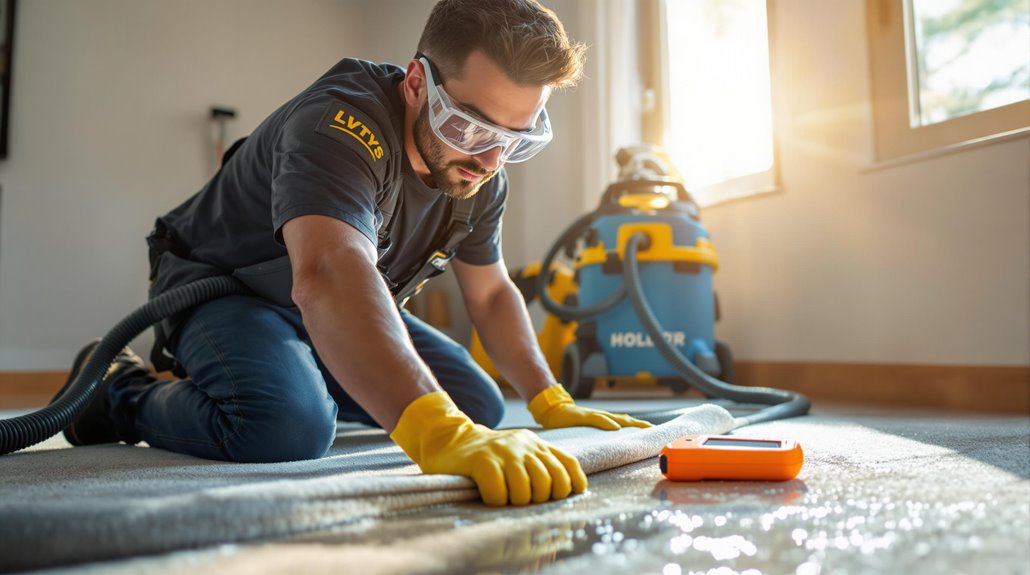As a Care Pro Restoration Technician, your day kicks off with a structured morning routine, prepping equipment and reviewing scheduled jobs. You respond swiftly to emergencies, evaluating damage while ensuring safety. Using specialized tools, you conduct thorough inspections to identify both visible and hidden issues. You implement effective restoration techniques, including water extraction and mold remediation. Client communication is key; you build trust through empathy and regular updates. Throughout your day, you follow strict safety protocols and continually improve your skills. Each experience teaches you something new about restoration and client care, revealing even more insights ahead.
Key Takeaways
- Start the day with a structured morning routine, preparing equipment and reviewing scheduled jobs for efficiency.
- Respond swiftly to emergencies by evaluating situations, securing areas, and addressing immediate hazards to ensure safety.
- Conduct detailed damage assessments using advanced tools like moisture meters and infrared cameras to identify and address hidden issues.
- Implement restoration procedures using specialized equipment for water extraction, drying, and mold remediation while adhering to safety protocols.
- Maintain clear communication with clients through regular updates and personalized interactions to build trust and ensure transparency throughout the process.
Morning Routine and Preparedness
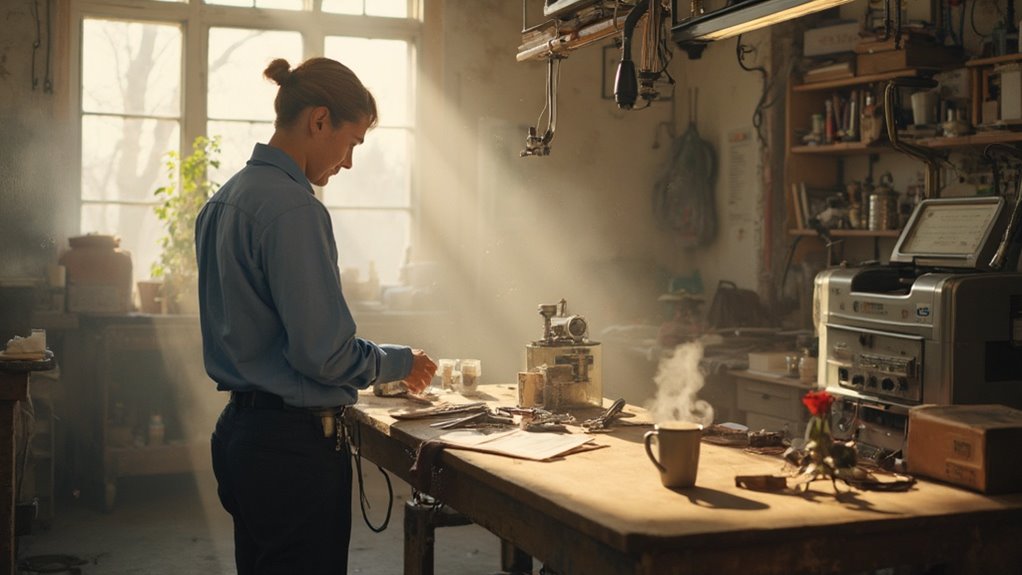
Starting your day as a Care Pro Technician requires careful preparation and attention to detail. Establishing effective morning rituals can set a focused tone for your tasks ahead. Waking up early, around 8 a.m., gives you the time to gather your thoughts and gear up without rushing. Preparing your equipment and clothing the night before guarantees everything is in its place and ready to go, streamlining your morning routine.
Minimizing screen time upon waking helps maintain clarity and energy. Fuel your body with a nutritious breakfast and hydrate with water; both are crucial for sustaining your physical and mental performance throughout the day. Additionally, understanding the importance of immediate action in water damage restoration can enhance your preparedness.
As you gear up, prioritize equipment readiness. Verify your personal protective equipment (PPE) is in proper condition and readily available. Conduct thorough inspections of safety devices and electrical connections, confirming their functionality to prevent hazards. Load necessary tools into your vehicle and keep everything organized for easy access. Finally, review the day's scheduled jobs to optimize your route and verify you're prepared for any unforeseen challenges. Mastering these morning rituals and checks primes you for success in your role. Additionally, being well-prepared enhances your ability to handle emergencies that may arise during the day.
Emergency Response Protocol
When an emergency strikes, you need to act quickly and decisively to minimize damage and protect safety. Your immediate steps involve evaluating the situation, securing the area, and ensuring that any critical hazards are addressed first. By following established safety protocols, you not merely safeguard your team but likewise reassure those affected that help is on the way. Additionally, utilizing advanced water extraction techniques is essential for efficiently managing the situation and preventing further damage.
Immediate Action Steps
Upon arriving at the scene of an emergency, your first priority is to conduct an immediate assessment and evaluation of the damage. Quickly inspect the affected areas to identify the extent and type of damage—whether it's because of water, fire, or storm. As you assess, be on the lookout for potential hazards like structural weaknesses, electrical risks, or contaminated water that could complicate your immediate response.
Next, take swift action to prevent further damage. This could mean shutting off water sources or securing damaged structures to mitigate risks like mold growth or electrical hazards. Communicate clearly with the property owner about the steps you're taking for damage control; transparency helps build trust in these stressful situations.
Document your findings meticulously for insurance purposes and to inform your action plan. Determine the required scope of work based on your assessment, and coordinate necessary resources to address the emergency efficiently. By executing these immediate action steps, you not only stabilize the situation but furthermore lay the groundwork for effective restoration that follows.
Safety Protocols Followed
Following your immediate action steps, implementing safety protocols is crucial to guaranteeing a secure environment for both you and the property owner. Start with a thorough hazard evaluation, identifying any water, smoke, or fire damage. Check for potential health risks, structural weaknesses, or electrical hazards that could compromise safety. Verify you have the necessary personal protective equipment (PPE) before proceeding.
Once you've assessed the hazards, focus on securing the job site. This involves shutting off any utilities to prevent further damage and restricting unauthorized access. Clear the area of debris and potential hazards to maintain site security. If there are vacant spaces, be certain duct plugs are in place to protect them.
Communication is key; keep property owners informed about the situation and your immediate actions. Coordinate with public emergency services as needed, and maintain accurate documentation for insurance purposes.
Damage Assessment Process
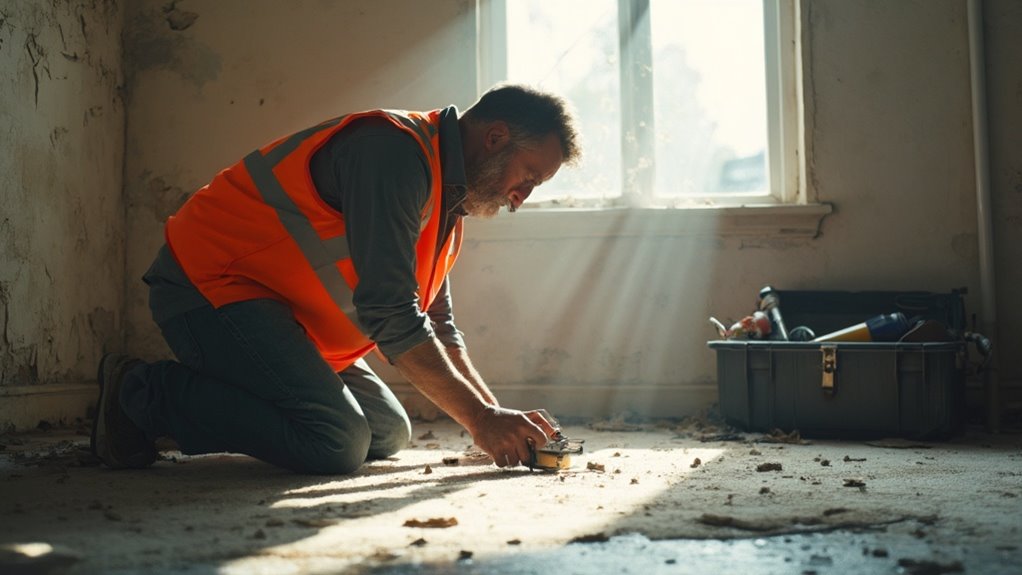
In the damage assessment process, you begin with a meticulous property inspection and evaluation, focusing on identifying both visible and hidden signs of water, mold, or fire damage. You carefully examine walls, ceilings, and floors for discoloration, swelling, or buckling, documenting the initial condition of the property for insurance claims and restoration planning. This detailed damage evaluation helps determine the scope of necessary restoration efforts.
Next, you employ advanced moisture detection tools, using pin and pinless moisture meters to gauge moisture levels in various materials. Infrared cameras assist in detecting hidden pockets of moisture, allowing you to create extensive moisture maps that pinpoint areas requiring immediate attention. You furthermore measure humidity levels with hygrometers to assess the environment's overall condition.
Moreover, you evaluate the property's structural integrity, checking beams, joists, and foundations for stability while identifying any safety hazards. This thorough approach guarantees not just the identification of damage but also the establishment of initial measures to secure the property. By combining empathy with technical expertise, you lay the groundwork for effective restoration, guaranteeing the safety of both the occupants and your team.
Restoration Procedures Overview
In the restoration process, you'll utilize specialized cleaning techniques and equipment to address water damage effectively. You'll additionally implement mold remediation processes to guarantee a safe environment and repair structural elements to restore the integrity of the property. Each step is vital in transforming a damaged space back into a safe and functional home.
Cleaning Techniques and Equipment
When tackling restoration projects, understanding the right cleaning techniques and equipment is crucial for achieving effective results. Your equipment selection greatly influences the success of water extraction, dehumidification, and odor removal. For instance, truck-mounted vacuums excel in quickly extracting standing water from large areas, while extractors like heavy-duty shop vacs are perfect for carpets and hardwood floors. Submersible pumps come in handy for flooded locations, ensuring thorough water removal.
Once the water's out, you'll need dehumidifiers to eliminate moisture from the air, protecting against mold growth. Pair these with air movers to improve drying efficiency, especially in challenging environments. Ductable and desiccant dehumidifiers offer specialized solutions for low temperatures.
For odor remediation, ozone machines and hydroxyl generators are effective in breaking down smoke residues and neutralizing unpleasant smells. Equip yourself with thermal foggers for a solvent-based approach, and utilize HEPA vacuums for extensive cleaning, ensuring you leave no harmful particles behind.
Mold Remediation Processes
Effective cleaning techniques and equipment lay the groundwork for successful mold remediation processes. First, you'll want to employ mold identification techniques through visual inspection and testing. This allows you to assess the extent of contamination accurately, which is essential for determining the scope of remediation. Next, isolate the affected area to prevent further spore spread by using plastic sheets and sealing ventilation ducts.
| Step | Action | Purpose |
|---|---|---|
| Identify | Conduct visual inspections and testing | Determine mold presence |
| Assess | Evaluate contamination extent | Define remediation scope |
| Contain | Seal off affected areas | Prevent cross-contamination |
| Remove | Dispose of infested materials | Stop further mold growth |
Once you've contained and assessed the situation, remove and dispose of materials that can't be cleaned, like drywall or insulation. Address underlying causes, such as moisture, to prevent recurrence. Finally, confirm the area is restored to its pre-mold condition and conduct final inspections to validate safety. Each step is significant in guaranteeing a thorough and effective remediation process.
Structural Repair Methods
Structural repair methods are crucial in restoring the integrity of a building after damage, ensuring safety and longevity. You start with a thorough structural assessment, identifying underlying causes of the damage, which guides your restoration plan. This plan outlines critical repair techniques tailored to address specific issues, prioritizing safety and compliance with industry standards.
Crack repairs are often your first focus. You might employ crack stitching to reconnect masonry or use carbon fibre reinforcement to strengthen compromised walls. For foundation issues, consider underpinning to provide additional support or screw piles to connect the building securely to the ground.
Once the structural integrity is assured, you shift to the repair and reconstruction phase. This involves cleaning up hazards and performing structural repairs on walls, ceilings, and floors. You'll need to decide between restoration and replacement of materials, ensuring every choice aligns with safety and quality.
Throughout, you maintain meticulous documentation of the damage and repairs, vital for insurance claims and project tracking. Your commitment to quality control at each stage guarantees that you meet both client expectations and industry standards, solidifying the restored structure's durability.
Safety Practices and Guidelines
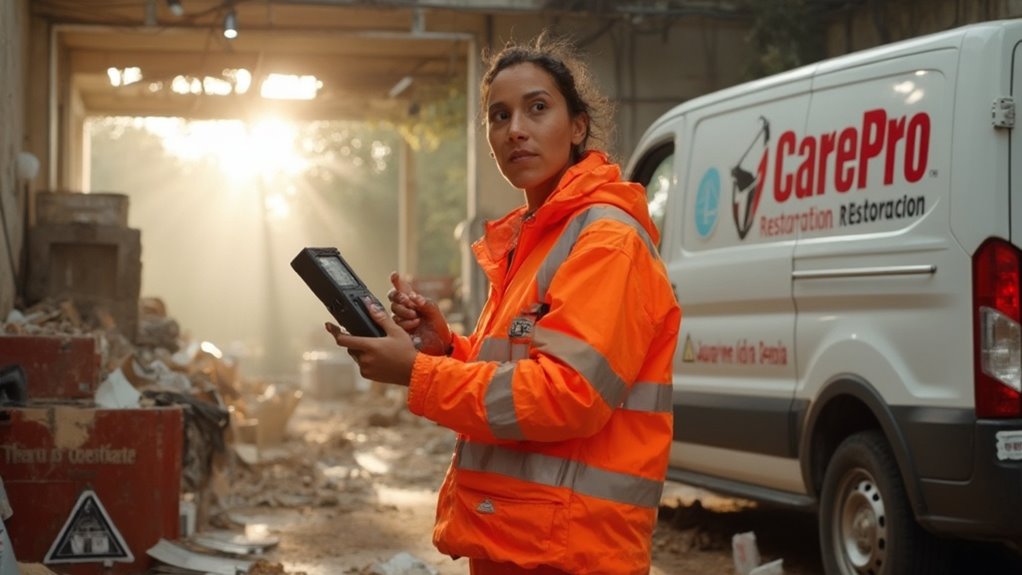
Safety is paramount in every restoration project, guaranteeing not just the well-being of the team but as well the integrity of the work environment. Establishing a strong safety culture starts with thorough risk assessments. As you assess each site, identify potential hazards like hazardous materials and structural instabilities, documenting everything meticulously. Don't forget to label hazardous areas clearly and address unsafe conditions immediately.
Personal protective equipment (PPE) is your first line of defense. Always wear the appropriate gear—respirators, goggles, gloves, and hazmat suits—making sure everything is well-maintained and regularly inspected. Your commitment to safety protocols is essential; develop clear procedures for hazard identification and safe work practices, and guarantee your team understands and follows them.
Emergency response plans must be in place for scenarios like chemical spills and structural collapses. Regular drills will prepare your team, making certain everyone knows their role. Maintain clear emergency exits and stay compliant with safety regulations. Remember, effective hazard communication is key. By prioritizing these practices, you not only protect yourself and your team but also uphold the standards of excellence expected in restoration work.
Communication With Clients
In the midst of a restoration project, clear communication with clients is vital for building trust and guaranteeing a smooth process. You'll want to employ various client engagement strategies to cultivate strong relationships. Start by personalizing your interactions:
- Use the client's name to create a personal connection.
- Reference specific project details, like the type of restoration or unique challenges faced.
- Keep clients informed with regular updates on progress and upcoming milestones.
- Show empathy by acknowledging their situation and any inconveniences.
- Utilize visuals to clarify technical details, improving understanding.
Effective feedback communication is additionally important. Automated project updates via restoration software can keep clients in the loop while maintaining transparency. This approach guarantees they understand every step of the process and feel valued. Remember to validate their emotions; expressing sympathy can greatly strengthen your rapport. By translating complex technical jargon into simpler terms, you'll minimize misunderstandings and improve their experience. Ultimately, your ability to communicate effectively and empathetically not only reassures clients but also raises the entire restoration process, making it a collaborative journey towards their peace of mind.
Tools and Equipment Utilization
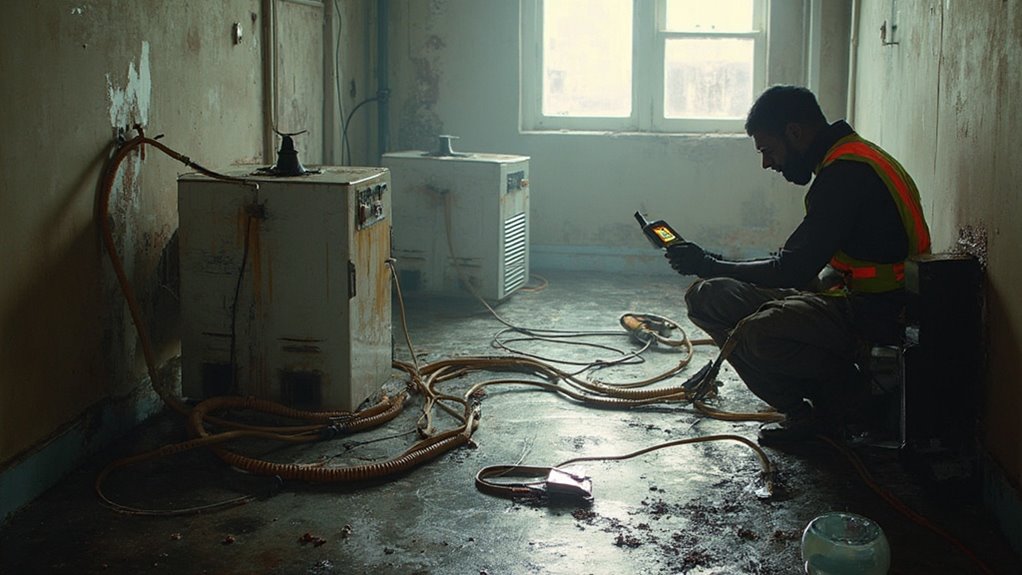
Efficiency in restoration projects hinges on the adept utilization of tools and equipment tailored for specific tasks. You'll rely on water extractors—both truck-mounted and portable units—to effectively remove water, while wet-dry vacuums serve as a temporary solution in emergencies. Selecting the right air movers—radial or axial types—accelerates the drying process, adhering to ANSI S500 standards. Low-grain refrigerant dehumidifiers are crucial for creating ideal drying environments.
Your tool selection extends to measurement and analysis tools, like moisture meters and hygrometers, which provide critical data on the drying process. Utilizing IR cameras and probe meters allows you to detect hidden moisture and guarantee thorough remediation.
Don't overlook the importance of equipment maintenance; regular checks and servicing prolong the life of your tools and maintain their efficiency. You likewise need personal protective equipment (PPE) for your safety, alongside vital hand tools for various tasks.
Lastly, keep business organizational tools—like project management software—handy to streamline operations. Mastering these tools not only improves your effectiveness but also guarantees a smooth workflow, ultimately benefiting your clients and your reputation in the restoration industry.
Continuous Learning and Development
As a Care Pro Technician, embracing continuous learning and development is vital not just for your career, but in addition for improving the quality of service you provide to clients. In a rapidly evolving industry, staying updated with the latest trends and technologies is fundamental for your success. Continuous education and professional certifications not only strengthen your expertise but likewise keep you competitive in the market.
Consider these key aspects of continuous learning:
- IICRC certification courses for water damage, fire restoration, and odor control.
- Subrogation training to meet TPA requirements.
- Specialized courses like Applied Microbial Remediation Technician (AMRT) and Water Restoration Technician (WRT).
- Opportunities for renewing certifications through ongoing education.
- Flexible training formats, including self-paced online courses and hands-on workshops.
Dedicating time to these learning experiences enriches your skill set and nurtures resilience against market changes. Engaging in discussions with instructors and fellow technicians can reveal new insights and methods, empowering you to deliver exceptional service. Remember, each step you take in your professional development improves not only your career prospects but also the lives of those you serve.
Conclusion
As a care pro restoration technician, your day is filled with critical tasks that demand precision and empathy. Did you know that 70% of homeowners have experienced some form of water damage? This statistic highlights the importance of your role in restoring not just properties, but peace of mind. By adhering to safety protocols and maintaining open communication with clients, you guarantee a thorough restoration process that truly makes a difference in their lives. Your work is invaluable.



